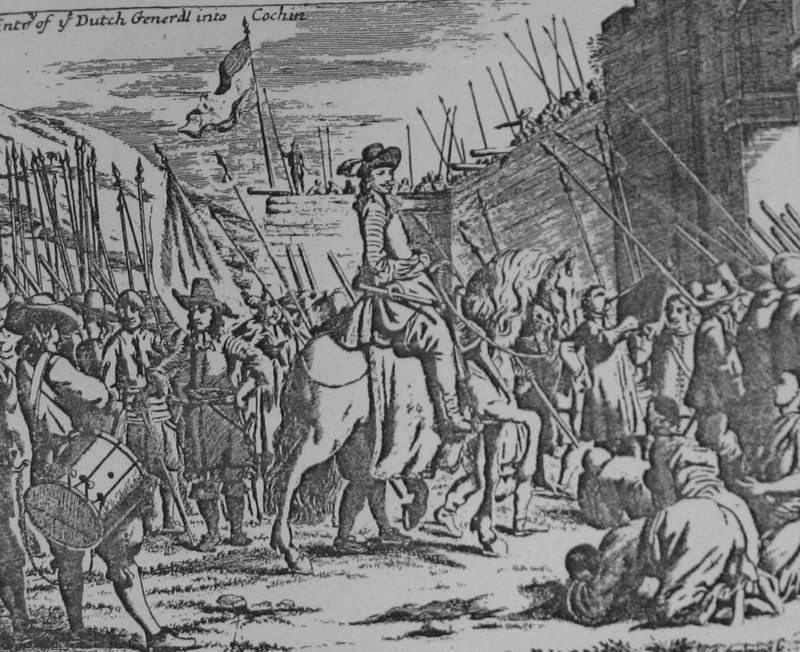Introduction to the Dutch Invasion of Kerala
The Dutch invasion of Kerala was a significant event in the history of southern India. It marked the arrival of European colonial powers and had lasting impacts on the region’s political and cultural landscape. This blog explores the key events, battles, and influences of the Dutch in Kerala, shedding light on their legacy.
Background: Kerala Before the Dutch Arrival
Before the Dutch arrived, Kerala was a busy trading area known for its spices, especially pepper. Traders from all over the world came to buy spices. The region was governed by different local kingdoms, like the powerful Zamorin of Calicut and the Kingdom of Cochin. These rulers traded and dealt with foreign traders, including the Portuguese, who were the first Europeans to settle in Kerala.
The Arrival of the Dutch East India Company
The Dutch East India Company (VOC) came to Kerala in the early 1600s. They wanted to control the spice trade, which the Portuguese dominated before. The Dutch set up trading posts and made deals with local rulers, offering military help in exchange for trading rights. They often fought with the Portuguese as they tried to take over the spice trade.

Major Battles and Conflicts
Battle of Colachel
The Battle of Colachel, fought in 1741, was a decisive conflict between the Dutch East India Company and the Kingdom of Travancore. The Dutch, led by Admiral Eustachius De Lannoy, faced the forces of Travancore under Maharaja Marthanda Varma. Despite their superior naval strength, the Dutch were defeated, marking a significant turning point in their ambitions in Kerala. This battle demonstrated the resilience and strategic prowess of the local rulers against European colonial powers.
Impact of Dutch Rule on Kerala
Dutch rule in Kerala had a profound impact on the region’s political and economic landscape. They introduced new agricultural practices and improved trade infrastructure. However, their attempts to monopolize the spice trade led to conflicts with local merchants and rulers. The Dutch also influenced the administrative systems, bringing in reforms that were aimed at increasing their control over the local economy.
Why Chilika Lake Should Be on Your Travel Bucket List
To know more click here:https://light.vintbit.com/uncategorized/chilika-lake-your-next-destination/
Cultural and Architectural Legacy
The Dutch left a lasting cultural and architectural legacy in Kerala. They built several forts and structures that still stand today, such as the Bolgatty Palace and the Dutch Palace in Mattancherry. These buildings reflect the blend of European and local architectural styles. The Dutch also influenced local art, cuisine, and customs, leaving an indelible mark on Kerala’s cultural heritage.
Dutch Contribution to Kerala
The Dutch had a lasting impact on Kerala. Before them, the Portuguese ruled Kochi for over a century. The Dutch ruled for a shorter time, but their influence continued, as the British who came later copied many of their practices. Scholars like K.P. Padmanabha Menon, K.M. Panicker, Dr. T.A. Punnen, and Prof. A. Sreedhara Menon studied the Dutch in detail.
The Dutch were more tolerant of other religions than the Portuguese, who strongly favored Catholics and caused conflicts. This led to tensions and protests, like the Rebellion of the Koonan Kurishu in 1653, where Syrian Christians vowed not to obey Latin Catholic priests and bishops. This event split the Syrian Christians into Romo Syrians and Jacobite Syrians. The Dutch, being Protestant, accepted changes in science and technology. Though initially against Roman Catholics, they changed their policies and built a Carmelite Church in 1673 and a seminary at Varahpuzha in 1682, which became St. Joseph’s Pontifical Seminary.
The Dutch East India Company (DEIC) also made offerings, like the Dutch bell at the Varkala temple and lamps in the Harippadu Temple.Dr. T.A. Punnen wrote about the Dutch in Kerala, covering their administration, reforms, trade, religion, and culture. His notable books include “Dutch Hegemony in Malabar” and “Lanthakkar Keralathil.”
End of Dutch Rule in Kerala
Dutch rule in Kerala began to decline in the late 18th century. The rise of British colonial power and internal conflicts weakened their control. By the early 19th century, the British had established dominance over Kerala, marking the end of Dutch colonial ambitions in the region. The Dutch presence in Kerala, however, had already significantly shaped the course of its history.1
Conclusion: The Dutch Influence on Kerala’s History
The Dutch invasion and subsequent rule in Kerala were pivotal in the region’s history. They brought about significant changes in trade, administration, and culture. While their rule was marked by conflicts and challenges, the Dutch left a lasting legacy that continues to be evident in Kerala’s architectural landmarks and cultural practices. Understanding this period provides valuable insights into the complex history of Kerala and its interactions with European colonial powers.

